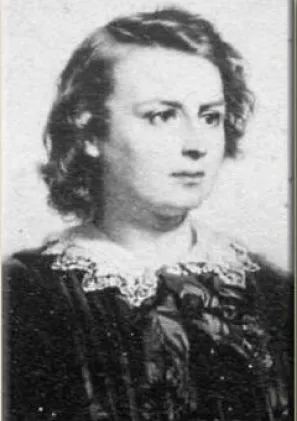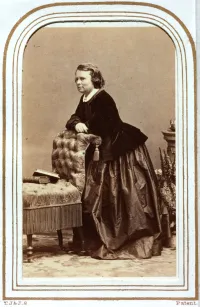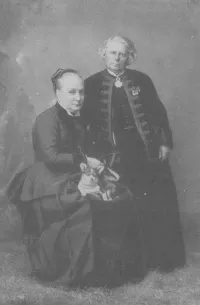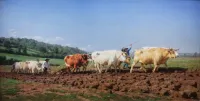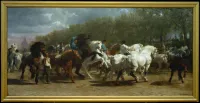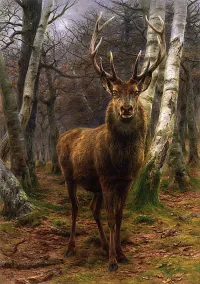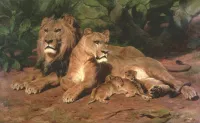Biography
1822 - 1899
"The epithets of imbeciles have never bothered me."
- Rosa Bonheur
Born into an artistic family, Rosa was raised a Saint-Simon - a religious sect that promoted the education of women and believed in a female messiah. When no art school of the era would accept her because she was a woman, she received artistic training from her father, artist Oscar-Raymond Bonheur. Rosa found her subject matter almost at once - since first picking up a brush or working with sculpture she had a fascination with the meticulous renderings of animals. Her work as an animalier (painter of animals) fit perfectly with the Realist school of painting and popular nature trend in art of the time. Though she painted hundreds of pieces, her two most enduring works are ‘Ploughing in the Nivernais’ (1849) and the monumental 8’ x 16’ painting ‘The Horse Fair’ (1855). International fame followed and she was even commissioned to do some pieces for Queen Victoria. Bonheur was a true nonconformist - smoking, cutting her hair short, visiting slaughterhouses to study animal anatomy, and wearing trousers in pubic (which she had to get a special license to do). Widely considered the most famous female painter of the 19th century, her behavior was tolerated because of her wealth and success. She lived with companion Nathalie Micas at her country estate for decades - upon her death Rosa lived with American painter Anna Elizabeth Klumpke. Her estate was also populated by an abundant variety of animals which included dogs, rabbits, horses, lions, and even an otter. When asked why she never married her standard reply was “I preferred to preserve my name.” She died in 1899 at the age of 77.
1822 - 1899
"The epithets of imbeciles have never bothered me."
- Rosa Bonheur
Born into an artistic family, Rosa was raised a Saint-Simon - a religious sect that promoted the education of women and believed in a female messiah. When no art school of the era would accept her because she was a woman, she received artistic training from her father, artist Oscar-Raymond Bonheur. Rosa found her subject matter almost at once - since first picking up a brush or working with sculpture she had a fascination with the meticulous renderings of animals. Her work as an animalier (painter of animals) fit perfectly with the Realist school of painting and popular nature trend in art of the time. Though she painted hundreds of pieces, her two most enduring works are ‘Ploughing in the Nivernais’ (1849) and the monumental 8’ x 16’ painting ‘The Horse Fair’ (1855). International fame followed and she was even commissioned to do some pieces for Queen Victoria. Bonheur was a true nonconformist - smoking, cutting her hair short, visiting slaughterhouses to study animal anatomy, and wearing trousers in pubic (which she had to get a special license to do). Widely considered the most famous female painter of the 19th century, her behavior was tolerated because of her wealth and success. She lived with companion Nathalie Micas at her country estate for decades - upon her death Rosa lived with American painter Anna Elizabeth Klumpke. Her estate was also populated by an abundant variety of animals which included dogs, rabbits, horses, lions, and even an otter. When asked why she never married her standard reply was “I preferred to preserve my name.” She died in 1899 at the age of 77.
Demography
Demography
Gender Female
Sexual Orientation Lesbian
Gender Identity Cisgender
Ethnicity Caucasian/White
Faith Construct Protestant
Nations Affiliated France
Era/Epoch Victorian Era (1837-1901)
Field(s) of Contribution
Art
Commemorations & Honors
First Woman to Receive the French Legion of Honor Grand Cross (1865)
Work Displayed at World's Columbian Exposition Palace of Fine Arts and Women's Building in Chicago (1893)
First Woman Artist to Receive the French Legion of Honor Officer of the Order (1894)
Demography
Gender Female
Sexual Orientation Lesbian
Gender Identity Cisgender
Ethnicity Caucasian/White
Faith Construct Protestant
Nations Affiliated France
Era/Epoch Victorian Era (1837-1901)
Field(s) of Contribution
Art
Commemorations & Honors
First Woman to Receive the French Legion of Honor Grand Cross (1865)
Work Displayed at World's Columbian Exposition Palace of Fine Arts and Women's Building in Chicago (1893)
First Woman Artist to Receive the French Legion of Honor Officer of the Order (1894)
Resources
Resources
Boime, Albert. "The Case of Rosa Bonheur: Why Should a Woman Want to be More Like a Man?" Art History 4 (1981): 384-409.
Chadwyck, Whitney. "The Fine Art of Gentling Horses and Women and Rosa Bonheur in Victorian England." The Body Imaged: The Human Form and Visual Culture Since the Renaissance. Kathlenne Alder and Marcia Pointon, eds. New York: Cambridge University Press, 1993. 89-107.
Klumpke, Anna. Memoirs of an Artist. Lilian Whiting, ed Boston: Wright and Potter, 1940.
Klumpke, Anna. Rosa Bonheur, sa vie, son oeuvre. Paris: Flammarion, 1908. Translated as The Artist's (Auto)biography: Rosa Bonheur by Anna Klumpke. Gretchen Van Slyke, trans. Amherst: University of Massachusetts Press, 1997.
Saslow, James M. "Disagreeably Hidden Construction and Constriction of the Lesbian Body in Rosa Bonheur's Horse Fair." The Expanding Discourse: Feminism and Art History. Norma Broude and Mary D. Garrard, eds. New York: HarperCollins, 1992. 187-206.
Van Slyke, Gretchen. "Addressing the Self: Cost, Gender and Autobiographical Discourse in l'Abbé de Choisy and Rosa Bonheur." Autobiography, Historiography, Rhetoric: A Festschrift in Honor of Frank Paul Bowman. Mary Donaldson-Evans, Lucienne Frappier-Mazur, and Gerald Prince, eds. Amsterdam: Rodopi, 1994. 287-302.
Van Slyke, Gretchen. "L'Autobiographie de Rosa Bonheur: Un testament matrimonial." Romanticisme 85.3 (1994): 37-45.
Van Slyke, Gretchen. "Does Genius Have a Sex? Rosa Bonheur's Reply." French-American Review 63. 21 (Winter 1992): 12-23.
Van Slyke, Gretchen. "Reinventing Matrimony: Rosa Bonheur, Her Mother, and Her Friends." Womens Studies Quarterly 19. 3-4 (Fall-Winter 1991): 59-77.
Weisberg, Gabriel. Rosa Bonheur: All Nature's Children. New York: Dahesh Museum, 1998.
http://en.wikipedia.org/wiki/Rosa_Bonheur
http://ringlingdocents.org/bonheurbio.htm
http://biography.yourdictionary.com/rosa-bonheur
http://www.riabrodell.com/_/Current_Work/Entries/2011/9/4_Rosa_Bonheur.html
https://theinkinquisition.com/2018/06/17/lgbtq-artist-spotlight-rosa-bonheur/
https://www.theartstory.org/artist/bonheur-rosa/
https://medium.com/fourth-wave/when-queer-artists-go-missing-720044bd8e49
Resources
Boime, Albert. "The Case of Rosa Bonheur: Why Should a Woman Want to be More Like a Man?" Art History 4 (1981): 384-409.
Chadwyck, Whitney. "The Fine Art of Gentling Horses and Women and Rosa Bonheur in Victorian England." The Body Imaged: The Human Form and Visual Culture Since the Renaissance. Kathlenne Alder and Marcia Pointon, eds. New York: Cambridge University Press, 1993. 89-107.
Klumpke, Anna. Memoirs of an Artist. Lilian Whiting, ed Boston: Wright and Potter, 1940.
Klumpke, Anna. Rosa Bonheur, sa vie, son oeuvre. Paris: Flammarion, 1908. Translated as The Artist's (Auto)biography: Rosa Bonheur by Anna Klumpke. Gretchen Van Slyke, trans. Amherst: University of Massachusetts Press, 1997.
Saslow, James M. "Disagreeably Hidden Construction and Constriction of the Lesbian Body in Rosa Bonheur's Horse Fair." The Expanding Discourse: Feminism and Art History. Norma Broude and Mary D. Garrard, eds. New York: HarperCollins, 1992. 187-206.
Van Slyke, Gretchen. "Addressing the Self: Cost, Gender and Autobiographical Discourse in l'Abbé de Choisy and Rosa Bonheur." Autobiography, Historiography, Rhetoric: A Festschrift in Honor of Frank Paul Bowman. Mary Donaldson-Evans, Lucienne Frappier-Mazur, and Gerald Prince, eds. Amsterdam: Rodopi, 1994. 287-302.
Van Slyke, Gretchen. "L'Autobiographie de Rosa Bonheur: Un testament matrimonial." Romanticisme 85.3 (1994): 37-45.
Van Slyke, Gretchen. "Does Genius Have a Sex? Rosa Bonheur's Reply." French-American Review 63. 21 (Winter 1992): 12-23.
Van Slyke, Gretchen. "Reinventing Matrimony: Rosa Bonheur, Her Mother, and Her Friends." Womens Studies Quarterly 19. 3-4 (Fall-Winter 1991): 59-77.
Weisberg, Gabriel. Rosa Bonheur: All Nature's Children. New York: Dahesh Museum, 1998.
http://en.wikipedia.org/wiki/Rosa_Bonheur
http://ringlingdocents.org/bonheurbio.htm
http://biography.yourdictionary.com/rosa-bonheur
http://www.riabrodell.com/_/Current_Work/Entries/2011/9/4_Rosa_Bonheur.html
https://theinkinquisition.com/2018/06/17/lgbtq-artist-spotlight-rosa-bonheur/
https://www.theartstory.org/artist/bonheur-rosa/
https://medium.com/fourth-wave/when-queer-artists-go-missing-720044bd8e49
